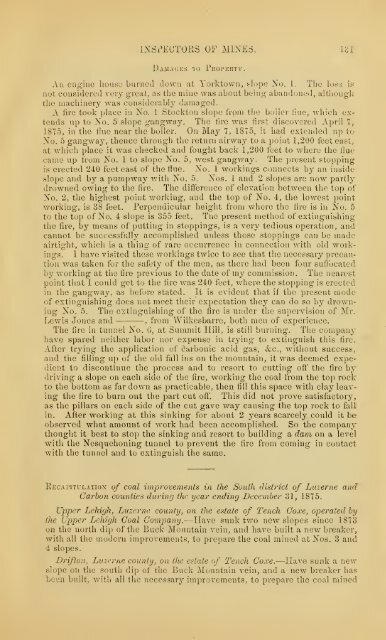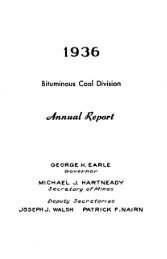Reports of the Inspectors of Mines of the anthracite coal regions of ...
Reports of the Inspectors of Mines of the anthracite coal regions of ...
Reports of the Inspectors of Mines of the anthracite coal regions of ...
You also want an ePaper? Increase the reach of your titles
YUMPU automatically turns print PDFs into web optimized ePapers that Google loves.
.<br />
INSi'KCTOKS OF .MINES. 121<br />
Damages io PRorERTY.<br />
All engine house burned down at Yorktown, f-Lipo No. 1. The hjss is<br />
not considered very great, as <strong>the</strong> mine was about being aband(;ned, altliough<br />
<strong>the</strong> machinery was considerably damaged.<br />
A lire took place in No. 1 Stockton slope frpm tlie boiler iiue, which extends<br />
\ip to No. 5 slope gangway. The tire was first discovered April 7,<br />
1875, in <strong>the</strong> tlue near <strong>the</strong> boiler. On May 1, 1875, it had extended up to-<br />
No. 5 gangway, <strong>the</strong>nce through <strong>the</strong> return airway to a point 1,200 feet east,<br />
at which place it was checked and fought back 1,200 feet to where <strong>the</strong> flue<br />
came up from No. 1 to slope No. 5, Avest gangway. The present stopping<br />
is erected 240 feet east <strong>of</strong> <strong>the</strong> flue. No. 1 workings connects by an inside<br />
slope and by a pumpway with No. 5. Nos. 1 and 2 slopes are now partly<br />
drowned owing to <strong>the</strong> fire. The diiference <strong>of</strong> elevaticui between <strong>the</strong> top <strong>of</strong><br />
No. 2, <strong>the</strong> highest point working, and <strong>the</strong> top <strong>of</strong> No. 4, <strong>the</strong> lowest point<br />
working, is 38 feet. Perpendicular height from where <strong>the</strong> fire is in No. 5<br />
to <strong>the</strong> top <strong>of</strong> No. 4 slope is 355 feet. The present method <strong>of</strong> extinguishing<br />
<strong>the</strong> fire, by means <strong>of</strong> putting in stoppings, is a very tedious operation, and<br />
cannot be successfr.lly accomplished unless those stoppings can be made<br />
airtight, which is a thing <strong>of</strong> rare occurrence in connection with old workings.<br />
I have visited <strong>the</strong>se workiTigs twice to see that <strong>the</strong> necessary'' precaution<br />
v.'as taken for <strong>the</strong> safety <strong>of</strong> <strong>the</strong> men, as <strong>the</strong>re had been four suffocated<br />
by working at <strong>the</strong> fire previous to <strong>the</strong> date <strong>of</strong> my commission. The nearest<br />
point that 1 could get to <strong>the</strong> fire was 240 feet, where <strong>the</strong> stopping is erected<br />
in <strong>the</strong> gangway, as before stated. It is evident that if <strong>the</strong> present mode<br />
<strong>of</strong> extinguishing does not meet <strong>the</strong>ir expectation <strong>the</strong>y can do so by drowning<br />
No. 5. The extinguishing <strong>of</strong> <strong>the</strong> fire is under <strong>the</strong> supervision <strong>of</strong> Mr.<br />
Lev.ns Jones and , from Wilkesbarre, both men <strong>of</strong> experience.<br />
The fire in tunnel No. G, at Summit Hill, is still burning. The company<br />
have spared nei<strong>the</strong>r labor nor expense in trying to extinguish this fire.<br />
After trying <strong>the</strong> application <strong>of</strong> carbonic acid gas, &c., without success,,<br />
and <strong>the</strong> filling up <strong>of</strong> <strong>the</strong> old fall ins on <strong>the</strong> mountain, it was deemed expedient<br />
to discontinue <strong>the</strong> process and to resort to cutting <strong>of</strong>t" <strong>the</strong> fire by<br />
driving a slope on each side <strong>of</strong> <strong>the</strong> fire, working <strong>the</strong> <strong>coal</strong> from <strong>the</strong> top rock<br />
to <strong>the</strong> bottom as far down as practicable, <strong>the</strong>n fill this space with clay leaving<br />
<strong>the</strong> fire to burn out <strong>the</strong> part cut <strong>of</strong>t'. This did not prove satisfactory,<br />
as <strong>the</strong> pillars on each side <strong>of</strong> <strong>the</strong> cut gave way causing <strong>the</strong> top rock to fall<br />
in. After working at this sinking for about 2 years scarcely could it beobserved<br />
what amount <strong>of</strong> work had been accomplished. So <strong>the</strong> company<br />
thought it best to stop <strong>the</strong> sinking and resort to building a dam on a level<br />
with <strong>the</strong> Nesquehoning tunnel to prevent <strong>the</strong> fire from coming in contactwith<br />
<strong>the</strong> tunnel and to extinguish <strong>the</strong> same.<br />
Eecapitulation <strong>of</strong> <strong>coal</strong> improvements in <strong>the</strong> South district <strong>of</strong> Luzerne and<br />
Carbon counties during <strong>the</strong> year ending December 31, 1875.<br />
Upper Lehigh, Luzerne county, on <strong>the</strong> e^^tate <strong>of</strong> Tench Goxe, operated by<br />
<strong>the</strong> Upper Lehigh Goal Company —Have sunk tv.'o new slopes since 1873<br />
on <strong>the</strong> north dip <strong>of</strong> <strong>the</strong> Buck Mountain vein, and have built a new breaker,<br />
with all <strong>the</strong> modern improvements, to prepare <strong>the</strong> <strong>coal</strong> mined at Nos. 3 and<br />
4 slopes.<br />
Drifton, Luzerne county, on <strong>the</strong> estate <strong>of</strong> Tench Coxe.—-Have sunk a new<br />
slope on <strong>the</strong> south dip <strong>of</strong> <strong>the</strong> Buck Mountain vein, and a new breaker has<br />
been built, with all <strong>the</strong> necessary improvements, to prepare <strong>the</strong> <strong>coal</strong> mined




![1945 Anthracite Annual Report Districts 19 - 25 [Adobe pdf - 9148Kb]](https://img.yumpu.com/50308099/1/190x119/1945-anthracite-annual-report-districts-19-25-adobe-pdf-9148kb.jpg?quality=85)


![1937 Anthracite Annual Report Districts 1 - 11 [Adobe pdf - 9394Kb]](https://img.yumpu.com/43539962/1/190x119/1937-anthracite-annual-report-districts-1-11-adobe-pdf-9394kb.jpg?quality=85)







![1931 Anthracite Annual Report Districts 1 - 11 [Adobe pdf - 8007Kb]](https://img.yumpu.com/39427789/1/190x119/1931-anthracite-annual-report-districts-1-11-adobe-pdf-8007kb.jpg?quality=85)

